We traveled to the Windy City to visit our son during the Independence Day holiday. The River North area downtown was where we stayed and the atmosphere was vibrant and festive.
Chicago’s many skyscrapers are always neat to see and photograph. The iconic Wrigley Building was adorned with a huge American flag. As this site reveals, the huge flag cost $6,200 and has been flown during the 4th of July period since 2002 as a way to commemorate the 9/11 attacks.
To the left of the Wrigley Building is the 100-story Trump International Hotel & Tower, the city’s second tallest building. The hotel cost a whopping $847 million to build and was completed in 2009.
We had a wonderful view from room 1526 in the Westin Chicago River North Hotel on N. Dearborn St.
Sunday afternoon when we checked into our room, this was the view.
Fortunately, the rain ended within a few hours…
...and the weather was very comfortable for walking, boating and kayaking. The Chicago River was bustling with vessels large and small.
We got out on the water ourselves on July 4th. At the Navy Pier, we boarded a tall sailing ship called Windy.
The weather turned hot and humid but on Lake Michigan it was very pleasant. The guide had fun facts and funny stories, even doing a good Donald Trump imitation when talking about his big hotel.
my interest in old lighthouses was satisfied with the Chicago Harbor Light that has been here since 1919.
I'm not sure if the lighthouse is still active but there is an effort to restore it and maybe turn it into a museum. More here.
Joseph joined us from New York and it was great seeing him so soon after our birthday/Memorial Day weekend visit with him in the Big Apple.
Ahoy matey!
Chicago skyline as seen from the Windy on Lake Michigan. The guide said the heavy boom pole at the top of my photo is called that because if a sailor got hit by the quickly moving pole that boom would really hurt. Sounds reasonable to me!
Justin was under the weather so unfortunately didn’t join us for this outing.
We did see Justin every evening for dinner, plus we met his girlfriend Zoe for the first time!
July 4th dinner was a fine meal at S.K.Y. restaurant in the Lower West Side Pilsen neighborhood where Justin lives. We finished our meal just as fireworks shows erupted.
Streets were blocked off and residents lit off an amazing amount of professional-grade fireworks.
To follow are some of my photography by theme. This interesting piece called The Gentlemen Statues may have had even more people under umbrellas Sunday when it rained much of the day.
The installation has been on this plaza near the Trump Hotel since 2015. Ju Ming’s work is described on one online site as “blocky and minimalist, Ming’s signature style, reducing the figures to their basic forms.”
There is some impressive bas-relief art on the Chicago River bridges downtown.
This large structure, which dates to 1920, is called a bridge house. It is where workers would raise the bridge for passing ships. At the time of its completion more than 100 years ago the bridge was considered an engineering marvel, and is still admired today for its mechanical prowess, per this site.
This Michigan Avenue work is one example. It has a lot going on: an angel (?) floating or being carried by soldiers, a mother tightly holding her baby while riding a horse. There is also a cow, a hatchet and many guns.
OK, upon research, the "floating" figure is the man credited as being Chicago’s first European settler, Jean Baptiste Point DuSable. The woman must be his wife holding their child.
This bridge is named in his honor and has four of these bridge houses each featuring a dramatic bas-relief sculpture depicting an important event in this great city’s history.
Wow, a little research determined that the large metal art piece outside the Richard J. Daley Center at 50 W. Washington St. was created by none other than Pablo Picasso himself!
The City of Chicago in 1963 commissioned the great Spanish artist to create a large public art piece to “anchor” the Daley civic center. And did Pablo come through! In 1967 his unnamed creation was unveiled amid great fanfare. It stands 50 feet tall and weighs 160 tons.
Made by U.S. Steel in neighboring Gary, Ind., the steel is the same type used to construct the Daley Center. Picasso apparently did not personally attend the dedication. Instead, in a dedication letter, he said he gave the sculpture to the people of Chicago, without ever saying what the artist wanted it to represent.
Hey, check the box. I’ve seen in person a Picasso!
Directly across from Daley Center is the Cook County Courthouse, also called Courthouse Place, built in that classical style in the early 1900s.
Chicago’s City Hall is also housed here.
Many of these old buildings feature sculptural relief art. One site describes the Cook County building's art this way: "monumental, Classical Revival-style exterior of the present structure, which was designed to be a functional and efficient office building, symbolizes the strength, dignity, and vigor of the governmental functions it contains."
This large mural certainly caught my eye above the entrance to an office building at 120 N. LaSalle St. The mosaic is called The Flight of Daedalus and Icarus. The Greek myth tells the story of Daedalus inventing wings made of feathers and wax. He and his son are testing the wings in flight. The father had warned his son Icarus to not fly too close to the sun. But he does…the wings melt…and the boy dies.
Walking among these giant buildings is pretty easy between the river walks on both sides of the Chicago River, the several bridges that span it and the many streets that crisscross this urban landscape.
A river view of the Wrigley Building (left), the Tribune Tower (right foreground) and the DuSable Bridge.
The Wrigley Building on N. Michigan Ave. was completed in 1924. It became the headquarters of the world’s largest gum company. That’s a lot of gum sales to build this skyscraper!
Completed just a year earlier and close by on North Michigan is the Tribune Tower. It had long been home to one of America’s greatest newspapers, the Chicago Tribune. But in recent years the newspaper moved operations out to the suburbs. The grand Gothic Revival building is being transformed into luxury condominiums priced from $700,000 to $7 million.
And I came across reports that this newspaper facility is within the next few years going to become a,,,gulp… Bally’s Casino.
The city’s old and new contrast is exemplified in this image. That’s the 1869-built Chicago Water Tower, also on North Michigan Avenue but in the part known as the Magnificent Mile, known for its bounty of shopping opportunities.
The water tower was built to encompass the tall machinery of a powerful water pump that brought water from Lake Michigan. It’s the U.S.’s second oldest water pump. Louisville, Kentucky has the earliest one.
When open today the grand Gothic Revival structure is home to a museum and art exhibits.
While waiting for the elevator on Floor 15 of the awesome Westin River North out the window is this view. That’s the “corn on the cob” Marina Condominiums mentioned earlier on the right. The white wall on the left provides, to me, an interesting contrast. the buildings in the background complete the frame.
This massive Merchandise Mart. When completed in 1928 it was the worlds’s largest building. It was constructed for Marshall Field & Co. to consolidate the store’s wholesale activities that were scattered in 13 warehouses throughout Chicago.
Today the 25-story Merchandise Mart is home to retail and office space, boutiques, radio and TV stations (really?), and 11 floors of permanent showrooms. It would be interesting if tours were offered. The lobby had these unique-looking blue chairs that I had to try for myself…
Two years ago we watched a show of images projected onto the mart from across the Chicago River. Talk about big-screen TV! Here's the blog post from that August 2021 Chicago visit.
Nighttime is the right time for some dramatic photography! In the photo below, the Westin Chicago River North where we stayed is on the left.
Traditional straight lines are the form of these two giants. On the left is what for so long was called-and still is by many- the John Hancock Building. The insurance company pulled out its last offices in 2015. Our Misty tall ship guide said the 1969-built Hancock Tower is now officially called “875 North Michigan Avenue” after its address. But “Big John” remains the name many locals prefer. I do not know the name of the building on the right. The Hancock is much taller. It’s the ground-level perspective in play with my image.
I bet back in the day only the top executives had the corner offices in the big Burnham Center built in 1913 at 111. W. Washington St. The 22-story structure is named for architect and urban designer Daniel Burnham (1846-1912). He was a key figure in rebuilding and redesigning Chicago after the great fire of 1871. Navy Pier, Macy’s on State Street, Grant and Jackson Parks, and the Riverwalk are among Burnham’s many contributions to the city. Today Burnham Center has a residential component to go with its office space opportunities.
I wish I had a closer look at this church now that I know it is considered the world’s tallest church! The golden spire tops the First United Methodist Church of Chicago. It has 21 floors and stands 568 feet tall. Founded in 1831, it is also the city’s oldest church. This site tells how the floors are used today and, intriguingly, how there is a Sky Chapel in the spire 400 feet above the ground that has worship serevices three times a week. I’m filing this information away for our next Chicago visit!

This Chicago fire station has architecture similar to the old water tower featured earlier. It’s up to code we are sure.
We walked toward Lake Shore Drive and came upon Northwestern University’s business, medical and professional studies campus. The Gothic style matches NU’s Evanston main campus.
I’m a graduate of Northwestern (MSJ Journalism) and always like to revisit when in Chicago. We didn’t make it to Evanston this time, but seeing the Chicago campus gave me my purple fix!
Burberry building branding! On the Magnificent Mile of shopping utopia is this gem. This British luxury brand goes way back to 1856. It is known for its tartan check pattern. I have some Burberry cologne that came in a box that resembles this store design. Inside this Michigan Avenue shop be ready for a very personalized shopping experience.
You see some interesting and unusual reflections on the many glass Chicago skyscrapers. The distortions can border on the bizarre. Here are some that caught my eye.
On its website, the restaurant describes itself this way: “Pizzeria Portofino is a sun-drenched casual restaurant located directly on the Chicago riverfront offering hand-stretched pizzas, coastal wines, an expansive patio and breezy decor that will instantly transport you to the Italian Riviera.”
That’s a tour boat passing in the background.
Then we returned on 4th of July when the restaurant was packed and we were very lucky to get a table without having a reservation.
Joseph joined us the second time. We had delicious pizza both visits. It wasn’t the deep dish Chicago style that I was craving, but it was very good.
We enjoyed a variety of cuisine for dinner. Mexican restaurant Barrio was a short walk from the hotel. The portions were big, the service so-so, and none of us were blown away by the tastes.
We had better meals at a French restaurant Justin picked called Chez Joel Bistro Francais on Taylor Street in Little Italy.
Fourth of July we feasted at a Pilsen eatery called S.K.Y. Alesia and I each had this interesting fried chicken dish that came with a spicy hot sauce and creamed corn. Very tasty!
We really like the Westin River North Hotel. This was our third or fourth stay here. Note in this photo Pizzeria Portofino restaurant on the river to the left of the hotel.
The hotel has its own large deck that oversees the Chicago River and many of the city’s magnificent skyscrapers.
This is a female Mallard seen near a boating marina while we walked along the riverwalk toward Lake Michigan.









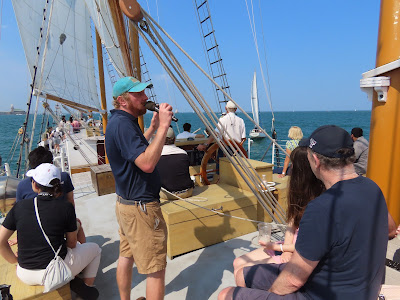

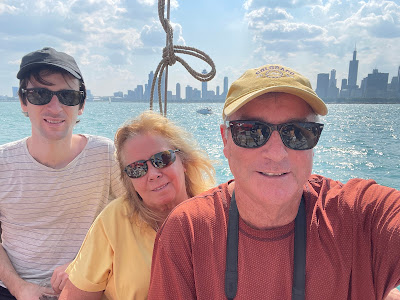































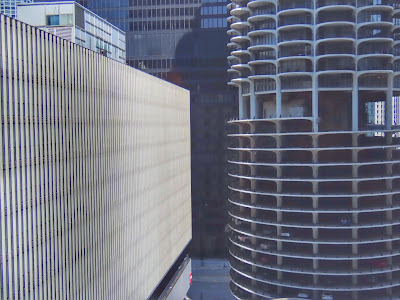




























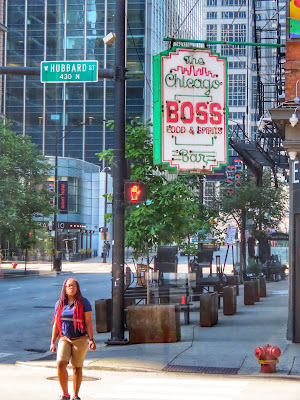














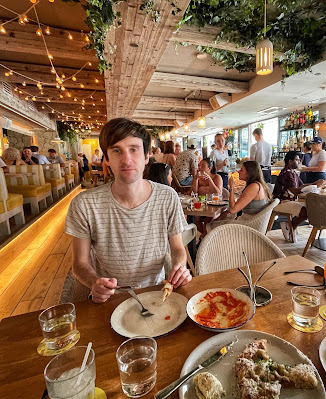















No comments:
Post a Comment